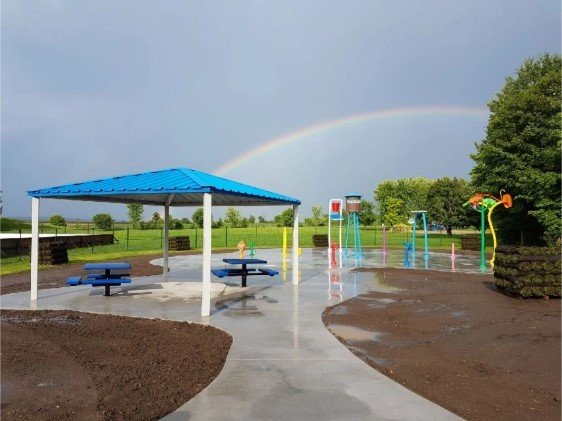Shade structures are essential additions to outdoor spaces, protecting from harsh sun, UV rays, and unpredictable weather. From playgrounds and parks to commercial courtyards and residential patios, shade structures enhance usability, comfort, and aesthetic appeal. This article explores their types, materials, benefits, and key considerations when selecting or installing shade structures.
What is a Shade Structure?
A shade structure is an architectural element designed to block or filter sunlight, reducing heat and UV exposure. These structures are used in a variety of settings, including:
- Playgrounds
- Schoolyards
- Parks
- Commercial outdoor seating
- Sports courts
- Pools
- Residential patios
Shade structures can be permanent or temporary and come in various designs to suit functional and aesthetic needs.
Types of Shade Structures
- Shade Sails
- Made from UV-resistant fabric stretched between anchor points.
- Offer a modern, stylish appearance and flexible installation angles.
- Ideal for playgrounds, pools, and outdoor dining areas.
- Cantilever Shades
- Supported by posts on one side, providing maximum shaded area with minimal obstructions.
- Commonly used for car parks, bleachers, and poolside seating.
- Hip Roof Shades
- Features a four-sided sloped roof supported by posts at each corner.
- Popular for playgrounds and picnic areas due to robust coverage and stability.
- Pergolas
- Open-roof structures with beams, often integrated with retractable canopies or climbing plants.
- Perfect for residential patios and garden seating areas, combining shade with aesthetic appeal.
- Gazebos and Pavilions
- Fully roofed structures provide complete shade and shelter from rain.
- Frequently installed in parks, community areas, and event spaces.
- Umbrellas
- Portable, adjustable, and easy to install.
- Common for cafes, restaurants, pool decks, and backyard seating areas.
Materials Used in Shade Structures
- Fabric
- High-density polyethylene (HDPE) is widely used for shade sails and canopies due to UV resistance and breathability.
- PVC-coated polyester fabrics provide waterproofing for permanent canopies.
- Metal
- Steel and aluminum are used for frames and posts due to their strength and durability.
- Powder coatings are applied for corrosion resistance and longevity.
- Wood
- Used primarily in pergolas and gazebos for a natural, aesthetic look.
- Requires regular maintenance to prevent weathering and termite damage.
- Polycarbonate Panels
- Used in cantilever roofs and pergola covers to block UV rays while allowing natural light to pass through.
Benefits of Installing Shade Structures
- UV Protection
- Shade structures block harmful UV rays, reducing the risk of sunburn and skin damage.
- Temperature Reduction
- They significantly lower temperatures in shaded areas, enhancing comfort for children, families, and customers.
- Extended Usability
- Outdoor spaces become usable throughout the day, increasing the functionality of parks, playgrounds, and patios.
- Asset Protection
- Shade over cars, playground equipment, or furniture prevents fading, cracking, and heat-related damage.
- Energy Efficiency
- When installed adjacent to buildings, shade structures reduce heat gain, lowering cooling costs.
- Enhanced Aesthetics
- Modern designs add visual appeal, increasing property value and customer attraction for commercial sites.
Key Considerations When Choosing a Shade Structure
- Purpose and Usage
- Define whether the structure will shade a playground, car park, seating area, or walkway to determine its size and design.
- Material Durability
- Select UV-stabilized, weather-resistant materials to ensure long-term performance with minimal maintenance.
- Design and Style
- Choose a design that complements your existing landscape and architectural aesthetics.
- Local Climate Conditions
- Consider wind load ratings, snow loads, and exposure to moisture or salt air in coastal regions.
- Safety Compliance
- Ensure the structure meets local building codes and safety standards for structural integrity and user safety.
- Maintenance Requirements
- Evaluate cleaning, inspection, and part replacement needs to maintain its condition and performance over time.
Maintenance Tips for Shade Structures
- Regularly inspect fabric tension, anchor points, and structural integrity.
- Clean fabric shades with mild soap and water to remove dirt, debris, and mildew.
- Check metal frames for rust or corrosion and touch up powder coatings when necessary.
- Tighten bolts and fittings periodically to maintain stability.
Conclusion
Shade structures are invaluable for enhancing outdoor comfort, safety, and aesthetic appeal in a wide range of settings. Whether you choose modern shade sails, robust cantilever canopies, traditional pergolas, or versatile umbrellas, investing in a quality shade structure transforms outdoor spaces into inviting, functional, and protected areas. Prioritizing material durability, design compatibility, and proper maintenance ensures your shade structure serves its purpose effectively for many years, benefiting communities, businesses, and families alike.




